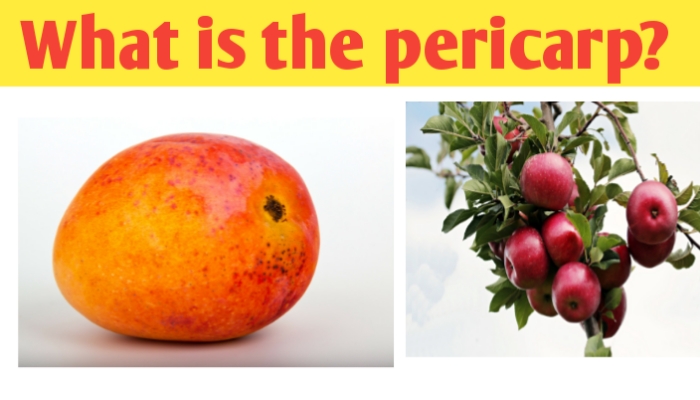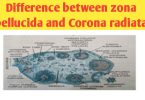What is the pericarp?, meaning, definition, functions and examples | what is a pericarp | what is the pericarp of a fruit | pericarp of corn | pericarp of wheat

What is the pericarp?, meaning, definition, functions and examples
Important characteristics feature of flowering plant is presence of double fertilization inside ovary of flower, there are two types of fertilization takes place inside ovary syngamy and triple fusion.
Product of triple fusion and syngamy is triploid endosperm and zygote respectively, further development zygote change into embro of seed, endosperm provide nutrition to developing embryo, integument change into seed coat and ovary wall after double fertilization modified to form outermost part of fruit known as pericarp that surrounding the seed and protect it from outer environment.
Table of Contents
What is the pericarp?
This is important questions for class 12th Biology students those who are preparing for their annual board and other competitive medical examinations.
The pericarp is outermost part of most of fruits that develop from ripened ovary wall after double fertilization, it may be hard, spiky, leathery, soft and membranous in nature. Usually pericarp of fruit consists of three layers, outermost layer is known as epicarp or exocarp, middle layer is mesocarp and innermost layer made of endocarp that surrounding the seed that present inside the fruit.
Regarding this, “what is called pericarp?”, the outermost part of most of fruits that develop from ripened ovary wall after double fertilization is called pericarp. Pericarp of true fruits develop from ovary wall that may be edible and protective in nature.
Pericarp forms edible part of most of fruit types like drupe and Berry, for example mango put in the category of drupe type fruit in which pericarp is well differentiated, easily recognise and distinguish into an outer thin, leathery epicarp, middle fleshy edible mesocarp and inner most hard and stony endocarp that surrounding the single seed of mango.
Regarding this, “what is a pericarp?”, a pericarp is define as outermost part of fruit formed from the wall of the ripened ovary. It consists of three distinct layers- outer epicarp or exocarp, middle layer mesocarp and inner most layer endocarp that surrounding the seed and protect it from outer environment. Pericarp is generally edible in most of fruit like mango, tomato, papaya, almond, custard apple, banana, etc, dry and membrane in coconut and leathery and protective in citrus family.
Regarding this, “what is the meaning of pericarp?”, the pericarp means outermost edible and protective part of fruit that formed from the wall of the ripened ovary and help in seed dispersal, provide food for animal and birds, provide raw material for making ropes and clothes and protection for seed and embryo by surrounding and covering them.
What are the examples of pericarp?
Peel and fleshy part of banana, thin outer skin and fleshy part of mango, membranous and fibrous part of coconut, peel of citrus fruit, thin outer skin and fleshy part of gauva, dry and hard outer seed coat of wheat, rice and corn, spiky outer part of jackfruit, highly reduced, soft and inner part of apple are few examples of the pericarp in fruits.
What is the pericarp of a fruit?
The pericarp of a fruit is the outermost part of most of fruit formed from the wall of the ripened ovary which may edible, in case of false fruit or accessory fruits it is highly reduced and present inside the fruit that surrounding the small seeds and may not be edible like in apple.
Pericarp in citrus fruits like lemon and orange, it forms the outermost, leathery, protective layer which may not be edible, juicy placental hairs are edible parts in citrus fruits.
In Drupe fruits like mango and supari, their mesocarp is edible, in berry fruit types like banana, grapes, cucumber and tomatoes their edible part is pericarp, endocarp and less developed mesocarp is edible part in banana, pericarp and Placenta is edible part in grapes, pericarp is edible in cucumber and pericarp along with seed is edible in tomato.
You can also click on the given link to see others topic in our website and YouTube channels
● Purines and Pyrimidine compare
How many types of pericarp?
In biology pericarp is defined as outermost part of most of fruit formed from the wall of the ripened ovary, edible in berry and drupe type fruit, protective in hesperidium type fruit and membranous in coconut.
Regarding this, “how many types of pericarp?”, there are three types of pericarp includes- 1) epicarp, 2) mesocarp and 3) endocarp, outermost, skin, thin, leathery, peel part is epicarp or exocarp, middle fleshy layer is mesocarp and innermost layer is endocarp that surrounding the fruit seed protect it from outer environment apart from plant protection.
What is the difference between epicarp and pericarp?
Key differences between epicarp and pericarp is that, epicarp is outermost part of most of pericarp of fruit, generally represented as thin in tomoto, leathery in mango, peel in banana spiky in jackfruit and membranous in coconut, and in most of case it is not edible, only provide protection whereas pericarp is the part of fruit develop from ovary wall, consist of three distinct layers, epicarp, mesocarp and endocarp which is most in case their mesocarp and endocarp is edible in nature.
What is the difference between mesocarp and endocarp?
Key differences between mesocarp and endocarp is that, mesocarp is fleshy middle layer of pericarp of most of fruit and it is edible in mango, tomato, banana, papaya, etc whereas endocarp is thin, hard or stony and innermost part of pericarp of fruit that surrounding the seed and protect it from outer environment apart from plant protection and it is edible in tomato, almond, wood apple, etc and stony in mango.
What is the difference between epicarp and endocarp?
Key differences between epicarp and endocarp is that, epicarp is outermost part of most of pericarp of fruit, generally represented as thin in tomoto, leathery in mango, peel in banana spiky in jackfruit and membranous in coconut, and in most of case it is not edible, only provide protection whereas endocarp is thin, hard or stony and innermost part of pericarp of fruit that surrounding the seed and protect it from outer environment apart from plant protection and it is edible in tomato, almond, wood apple, etc and stony in mango.
What is the difference between epicarp and mesocarp?
Key differences between epicarp and endocarp is that, epicarp is outermost part of most of pericarp of fruit, generally represented as thin in tomoto, leathery in mango, peel in banana spiky in jackfruit and membranous in coconut, and in most of case it is not edible, only provide protection whereas mesocarp is fleshy middle layer of pericarp of most of fruit and it is edible in mango, tomato, banana, papaya, etc and fiberous in coconut.
What is the pericarp function?
Key function of the pericarp are following:- 1) pericarp is ripened ovary wall formed from the outermost part of fruit, 2) it is edible in most of fruit like mango, banana, grapes that provide nutrition to the animals and birds, 3) it is consumed by various animals and birds thus help in seed dispersal, 4) in coconut fiberous mesocarp and membranous epicarp forms the husk of coconut that is used for making ropes and clothes and 5) it provide protection to the developing embryo and seed from outer environment apart from plant.
What is the pericarp of wheat?
The pericarp of wheat plant is thin, non edible, dry outermost layer of fruit type caryopsis that consist of 3 fused layers of outermost epicarp, middle mesocarp and innermost endocarp that surrounds the endosperm and embryo of the wheat seed and provide protection for it, and it will removed in several process before eating that’s why we only eat seed of wheat that contains endosperm and embryo.
What is the pericarp of corn?
The pericarp of Corn or maize is hard, non edible, thin, dry and outer coat of fruit type caryopsis that consist of 3 fused layers of outermost epicarp, middle mesocarp and innermost endocarp that surrounds the endosperm and embryo of the corn seed and provide protection for it, and it will removed in several process before eating that’s why we only eat seed of corn that contains endosperm and embryo.







Leave a Comment